
For the ultimate ramen experience, the bowl is just as important as the food it contains.
Can you imagine using a bowl for your ramen that is angled too high, and your chopsticks can’t function properly?
Or using a bowl where the opening is too small and toppings are forced to be piled on top of each other instead of being spread out enticingly as it should?
What about a bowl that is too shallow and your soup is overflowing and spilling out every time you try to grab at the contents?

Many factors, like the bowl’s shape, weight, exterior curvature, affect whether the ramen bowl is considered good or not.
A good ramen bowl is the fundamental building block for a diner to happily enjoy that bowl of ramen.
Japanese ramen chefs know this and that’s why you can see many different types of bowls being employed in a ramen restaurant.
There are so many different shapes of ramen bowls out there. Here I will introduce 7 of the most commonly used shapes:
1. Menbachi (麺鉢)

The name of this bowl literally means “noodle bowl”.
The shape of this bowl is usually bigger and deeper than other regular bowls.
In addition, this bowl has a large and wide opening, which makes it best used for noodles that come with a lot of soup.
2. Ohgigatadon (扇型丼)

Literally meaning “fan-shaped bowl”, this bowl is characterized by a straight and steep exterior side.
This bowl is very user-friendly in a commercial kitchen, as it is easy-to-hold, stackable and does not take up much storage space.
Because of its steep-angled body, the contents you can put in is much less than bowls of other shapes.
Unlike traditional bowls, this bowl is considered modern and very stylish and therefore, most commonly used in high-end restaurants that focus on quality of the noodles rather than quantity.
3. Tayoudon (多用丼)

The name of this bowl is literally translates into “multi-purpose” bowl.
This type of bowl is most commonly used in new ramen restaurants that were opened after 2000.
Typically, these restaurants are expensive and creative, straying away from your traditional ramen menu items like shoyu ramen, miso ramen, etc.
Because of this bowls’ multi-purpose function and shape, you can also use it for noodles other than ramen like udon or soba.
The shape of this bowl also makes it great for holding rice dishes as well, like katsudon or oyakodon.
4. Hira Tayoudon (平多用丼)

This is the flat version of the tayoudon mentioned above.
Because you can fit a lot of noodles in this type of bowl, it is usually used in low-end ramen restaurants that focus on offering high volume for cheap prices.
5. Tamadon (玉丼)

Literally meaning “ball-shaped bowl”, this round bowl is characterized by a thick and round mouth. A thicker lip makes the edge of the bowl harder to chip.
This bowl is typically used for ramen that come with many toppings.
6. Koudaidon (高台丼)

This “high-footed” bowl, as its name suggests, is characterized by a tall bottom, which allows the user to avoid burning themselves on the bottom of the bowl when holding it.
Usually, the lip of the bowl is slightly bent backwards, which allows the diner to easily see the soup, noodles, and toppings of the ramen in one glance.
This kind of bowl is most often used at budget restaurants that focus on convenience for the customer rather than the perception of the restaurant.
7. Marukoudaidon (丸高台丼)

This is the “rounded” version of the koudaidon bowl described above.
Similar to the characteristics mentioned above regarding the koudaidon bowl, this bowl has an additional rim on the mouth.
Most commonly used for ramen noodles or fried rice, this bowl makes it easy to serve as the extra lip makes it easy to grab and transport without burning your fingers.
Do you know how to select the correct ramen bowl size?

We want something that is big enough to fit all the noodles, soup and toppings without spillage, but also something that is not too big so its too heavy.
Let’s take a quick look at the most common sizes and what they are typically used for:
7.5 inches (19cm):
Great size for home-cooking. Will fit a pack of instant ramen noodles with a few toppings.
8 inches (20.5cm):
The most commonly-used size in restaurants.
9 inches (23cm):
Another popular size often used in restaurants (it allows the restaurants to include large portions of noodles, soup and toppings).
Measurements are in reference to the approximate diameter of the bowl.
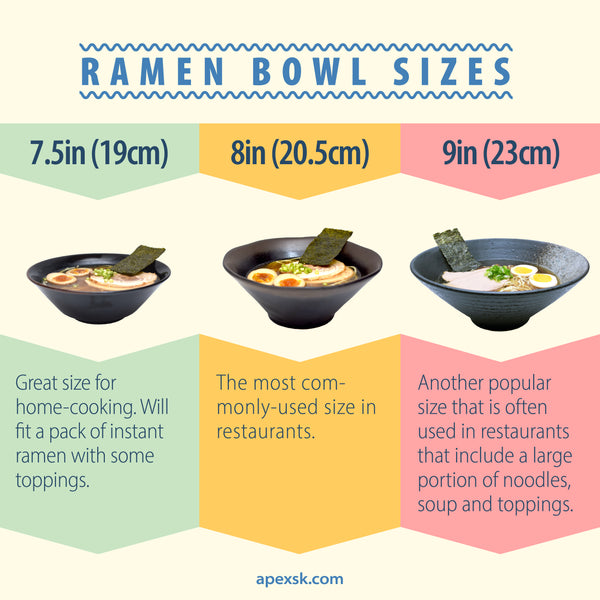
Bowls are interesting aren’t they?
It changes the perception of the ramen meal.
It is commonly said that the capacity of your ramen bowl should be at least 34oz or more (1000ml) because ramen consists of at least 17oz (500ml) of soup, noodles, and toppings.
Ramen Bowl Optimal Capacity
Did you know?
The Japanese believe there is a “golden" proportion between the bowl and the food contents.
The soup, noodles and toppings should only make up about 70 to 80% of the entire bowl.
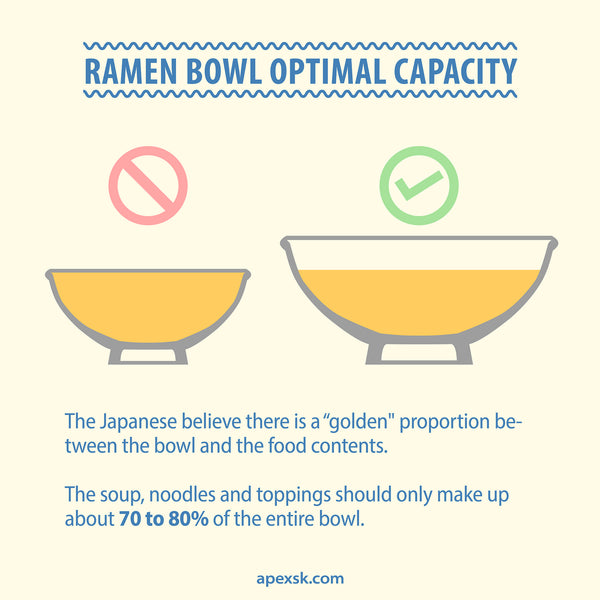
It doesn't look aesthetically beautiful if your soup, noodles, and toppings are too full in your bowl. (Not to mention the high risk of spilling!)
In addition, it is difficult to hold and move a full bowl of ramen noodle with bare hands since it is too heavy and hot.
In order to avoid burning and spiling, ramen bowls should be the right size for you and filled to about 70-80% of the bowl’s full capacity.
Ramen Bowl Capacity
34oz (1000ml):
Good size for home-cooking. This size will fit a pack of instant ramen with some toppings. However, they are too small for someone who would like to have a larger portions.
45oz (1350ml):
Commonly-used size in restaurants. It presents your ramen beautifully. They are nice and large, convenient to move around (even while filled), yet easy to store when not in use.
57oz (1700ml):
Another popular size that is often used in restaurants which can hold a large portion of noodles, soup and toppings. This size is considered a "heavy-duty" bowl.

Ramen Bowl Height
The height is also a key element of picking out the perfect ramen bowl.
It should be over at least 3 inches (7.5cm) in order to avoid the soup from getting cold quickly.
3 inches (7.5cm):
For home cooks - perfect size for one pack of instant noodles, toppings, and soup. This size is perfect for a small single serving.
3.5 inches (9cm):
Popular size at a restaurant. It can hold large portion of ramen.
4 inches (10cm):
Another popular size for professional and ramen enthusiasts. You don't need to worry about spilling soup. This size presents your ramen beautifully.
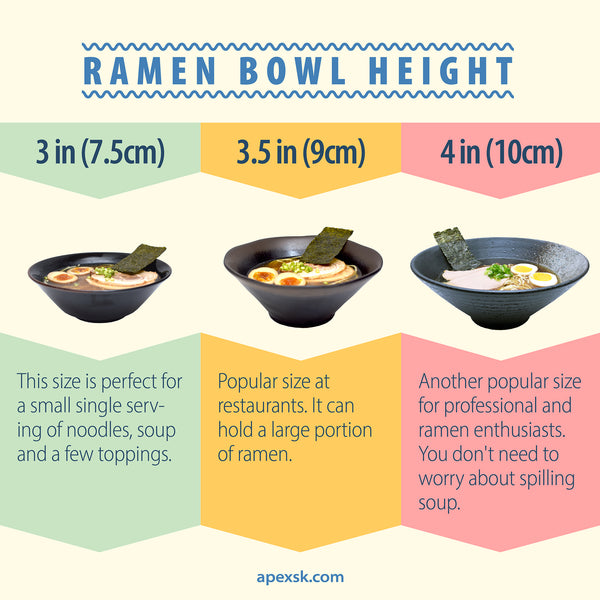
Ramen Bowl Parts
Have you ever thought about the different part names of the ramen bowl?
Knowing the names of these parts means you will gain a deeper understanding of your bowl and appreciate it even more.
Imagine enjoying delicious ramen in a beautiful bowl. The positive perception of your food makes the taste even better.
It is a Japanese tradition and belief that the enjoyment of food is not only on its taste but also on how it is presented visually.
There are 5 basic parts of a ramen bowl.
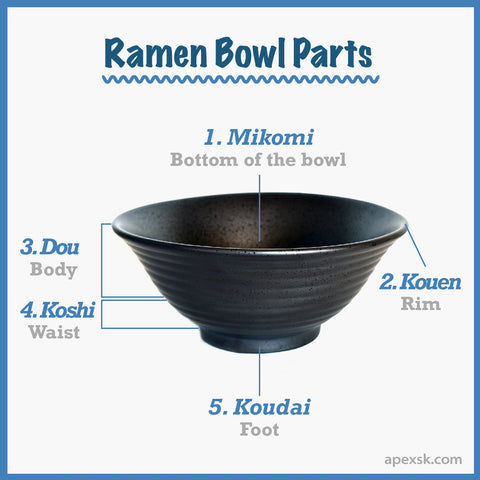
1. Mikomi (Bottom of the bowl’s inside)

The mikomi is the bottom of the inside of the bowl.
You look at the color of glaze, how the glaze covers the bottom, and some decorations or drawings if there are any.
When you finish eating, you might even see some drawing or calligraphy there.

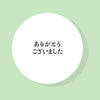
2. Koen (Rim)
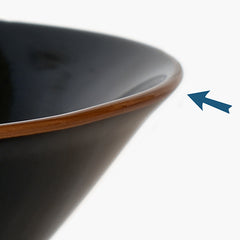
Literal meaning of koen in Japanese is “around the mouth".
The thickness of the koen changes the impression of the bowls.
People drink the ramen’s broth out of it, so it should be smooth and thin because it touches our lips.
However, if it is too thin, it can break easily, so be careful.
3. Dou (Body)
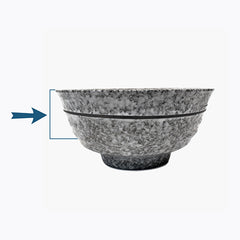
It is the part that is between koen (rim) and koshi (waist).
There might be some decoration on a ramen bowl's body, so make sure you enjoy the beautiful decorations or subtleties of this part of the bowl.
4. Koshi (Waist)
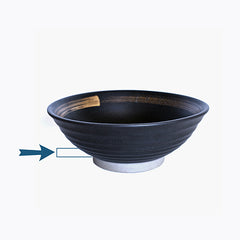
It is a part between dou and kodai.
5. Kodai/Koudai (Foot)
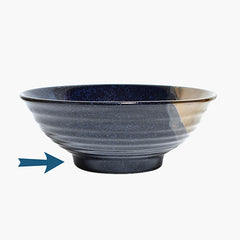
Kodai is the foot of the bowl.
It gives a bowl its stability.
When you put hot soup into a bowl, it is easy to hold the bowl by the kodai.
A bigger kodai gives the bowl more stability.
The name of bowl parts in Japanese are related to human body parts.
In Japanese culture, we sometimes like to give human attributes to inanimate objects.
For parts of bottles, we use words like:
Mouth, neck, ear (handle), shoulder, body, waist, koudai, bottom, and we also call the surface “skin”.
As you’ve learned today, ramen bowls are similar too!
Ramen Bowl Dimensions: 3 Secrets of Ramen Bowl Size You've Probably Never Heard of
Patterns and Colours of Ramen Bowls: Pick the Perfect One
Ohgigatadon: How to Create Restaurant-Like Ramen Noodles
Ramen Bowl Set: 5 Secrets of Ramen Bowl Sets You've Probably Never Heard of
Tayoudon: The Secret of Authentic Japanese Dining
Unboxing: 9" Black Melamine Ramen Bowl (Set of 4)
Ramen Bowl Material
Now that we’ve taken a look at some of the different bowl shapes and sizes most-commonly used to serve up ramen, let’s take a look at the different materials used to make a ramen bowl and what works best for your needs.
A ceramic ramen bowl keeps your ramen hot for a longer period of time than its melamine or plastic counterpart.
We’ve really delved into the world of ramen bowls today. The shape, size and material of the bowl, can really make or break that ramen experience.
Next time you’re enjoying a hearty bowl of ramen at a Japanese restaurant, maybe you can identify which type of bowl is being used!
About the Author

"I am from Ibaraki, Japan.
Ramen is great! It can bring you a sense of happiness and satisfaction that no other food can. I have been eating ramen for 30 years.
If there is no ramen, my life would be miserable.
Ten years ago, I worked as an office worker. The job was really stressful - excessive working hours, low wages, unpaid overtime work, and constantly being yelled at by my boss.
I was new and alone, no girlfriend, no friends, and felt very lonely.
My only oasis was the ramen shop near the office. For me, the ramen chef there was literally an angel. I saw a halo on his head. (No joke)
Tonkotsu shoyu ramen was my all-time favorite. He made ramen with broth chock-full of umami flavor, nice chewy handmade noodles, and tender chashu.
My greatest dream is connect people with ramen through my blog. I want to share a lot of interesting and funny stories and ramen trivia with you.
Knowing more about ramen can help you appreciate your ramen and make it taste extra delicious."







Hi Katie,
Thanks for leaving a comment! That is a great question, ramen bowls come in many different materials, I don’t see an issue with glass or recycled glass!
Hello thank you so much for all the information absolutely fascinating and exactly what I was looking for. Now, may I ask if it won’t cause an earthquake or major catastrophe … can you get glass ramen bowl or is that a no-no, even better recycled glass (green) ramen bowl? Many thanks
Hi Jo,
Thanks for your comment!
I’m so glad you found our article helpful!
Hope you were able to find some useful tips!
Hi I was doing some research on the size and proportions on ramen bowls, I am a potter in France and wanted to make some, I found your blog which had all that i wanted and more so Thank you for sharing.
Hi Liz! Thank you for your question and for finding us! Our products are designed in Japan and manufactured in one of our partner factories either in Japan or China.
Leave a comment